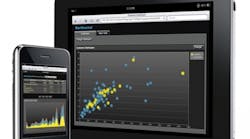Business Intelligence Gets Smart and Goes Mobile
Things are looking good for manufacturing -- the economy is picking up, orders are increasing and consumption is on the rise. But after the recession years, many companies have now found themselves slimmed down to the bare operational bones and entering the recovery period without the necessary staff or resources to meet increasing demand.
For manufacturers, this means doing more with less, better and faster than ever before.
To do this, many are finding that they now require access to real-time, actionable business intelligence (BI) when and where they need it most.
Which is to say, they must now have access to everything, everywhere, any time.
It's no wonder that when they turn to their old BI system for help, they find it can no longer cope with these new demands. In fact, it doesn't come close.
With terabytes of data updating in milliseconds, BI users are buried under a barrage of information that comes in too fast and in too great a supply to rationalize with traditional BI systems. So manufacturers are doing what one always does when demand outpaces means: They are turning to new technology. In this case, that means updating to a smarter system and taking it mobile.
The New BI Model
Mark Bernardo, general manager of automation software at GE Intelligent Platforms, recommends three questions executives should be asking about their Business Intelligence:
- "How do we take all of this disparate information and serve it up in a way that is incredibly fast?"
- "How do we aggregate it in such a way that you won't need the level of domain expertise that we needed in the past?"
- "How do we provide the right data to the right people so they can make business decisions in real-time?"
LogiXML solution, Logi Mobile, allows users to deliver data visualizations to any desktop, tablet, or phone from a single BI application.
The answer to these questions begins with smarter BI.
"The theory has always been to collect as much data as you can," says Bernardo. "I'd rather have the data and not need it than need the data and not have it."
This was easy to deal in the past, he says. Then, "you were only talking about 20,000 to 50,000 tags maybe updated every second or so." In those days it was fairly easy for a team of domain experts to reconcile and aggregate that data and deliver it to upper management in daily reports, he says.
"That was all great, but in today's business world, speed is of the essence and that process just takes too long," he says. "Now we have customers needing a half million points of disparate information rationalized on a second-by-second basis. It's just a mess."
The only way to deal with this, he says, is to update the BI model to provide accessible, real-time, actionable intelligence. "No matter how good you are, you can't make decisions fast enough," he says. "This is why there is such a push now for analytics, such a push for mobility."
The goal now, he says, is to "take that domain expertise, put it into the system and then push it out to the people that need it when they need it." Modern BI systems must therefore be able to take in all of these massive waves of data and "add analytics to it that perform the functions that a domain expert used to."
To this end, Bernardo says GE (IW 500/4) has made a transition to higher-end operating systems and leveraged back-end databases that can more effectively access memory systems for integration. Work with the historian systems has been especially critical to dealing with data overload, he says.
"A historian, by nature, is not in real time," he explains. "But historians are built for speed. They're built for that level of scale where you serve up millisecond needs through an architecture that we evolve on an ongoing basis."
With this system in place, GE can now sort and rationalize incredible amounts of data to help provide actionable information at nearly real time. Even with upgrades, however, no system will be complete without a certain degree of mobilization, Bernardo says.
Going Mobile
"I don't think you can compete efficiently today without mobility," says Mani Gill, vice president and general manager of SAP Business Intelligence. "People in the fields, people on the shop floor are absolutely going to require mobile experiences."
Today, he says, users require "traditional reporting capabilities along with the ability to do ad-hoc analyses, create dashboards and deploy them to executives and others in the organization."
Basically, this means the new BI systems must be designed with "an intuitive interface that doesn't require training," he says. In other words, the mobile devices BI users are already using.
It was this factor that led Multiquip Inc., a Carson, Calif.-based heavy equipment producer, to invest in a web-based BI program through LogiXML to help roll out a fleet of iPads to its sales force. According to Michael Hanken, vice president of IT at Multiquip, the company started looking at ways to improve its reporting capabilities about two years ago.
"Basically, the VP of sales wanted to have a 360 degree view application for our sales people that is instantaneously accessible in the dialog," says Hanken.
It wasn't long until they discovered this in the iPad.Loaded with a custom LogiXML application, Multiquip's sales force will soon have the ability to access product information, schedules and rates, and even generate instant quotes from their iPads.
The advantages of this will be manifold and immediate, he says. For example, he notes that in the past, "when a salesman had a question, he had to call back to the office. That's too time consuming today, too cumbersome. Better to deliver this information straight to him through a mobile device."
The quote-generating functions offer an equal productivity bump, he says. "In the old days, you basically had an array of price books where you had the list price and then you had discounts by customer," he says. "That has completely vanished. Everything is now in real-time, online, straight from the ERP system. This will eliminate a lot of paperwork, a lot of ambiguity in pricing and have it real-time to their fingertips."
With this system, Hanken expects a better, more efficient sales force that will one day even use the system to place immediate, on-the-spot orders.
The Future of BI
It is clear that the trend has been and will continue to be toward ever more mobile solutions. This isn't to say that it's already standard, however. "We have customers that are absolutely still in the old environment, as amazing as that is," says Bernardo. "These are very large, very sustainable businesses."
Even with the weight of their past success, however, these companies will have to make the transition if they want to maintain their edge in coming years.
"Is it still possible to do business without mobility? Absolutely," he says. "Is it still possible to remain competitive [without it]? The answer would be no."




